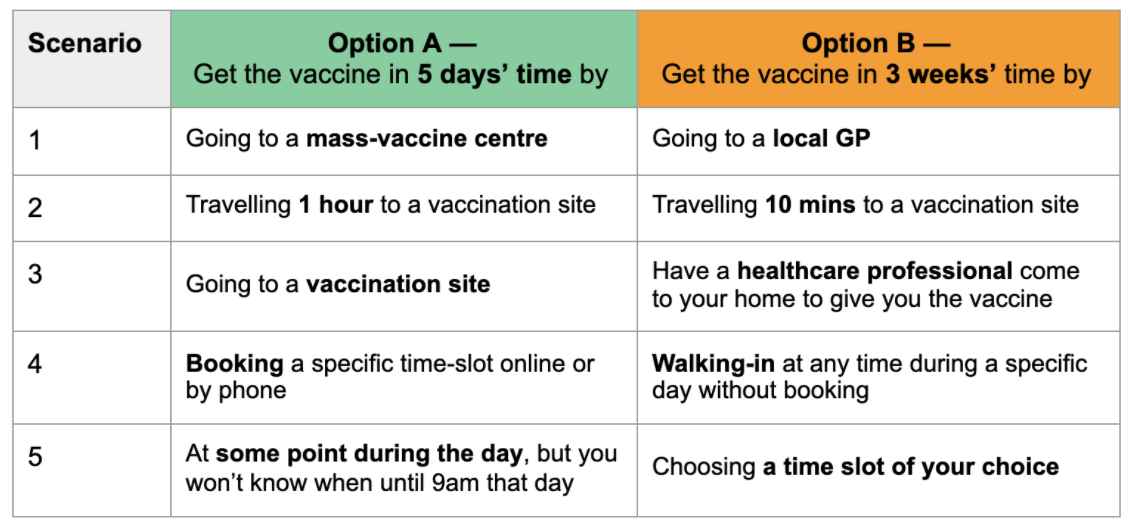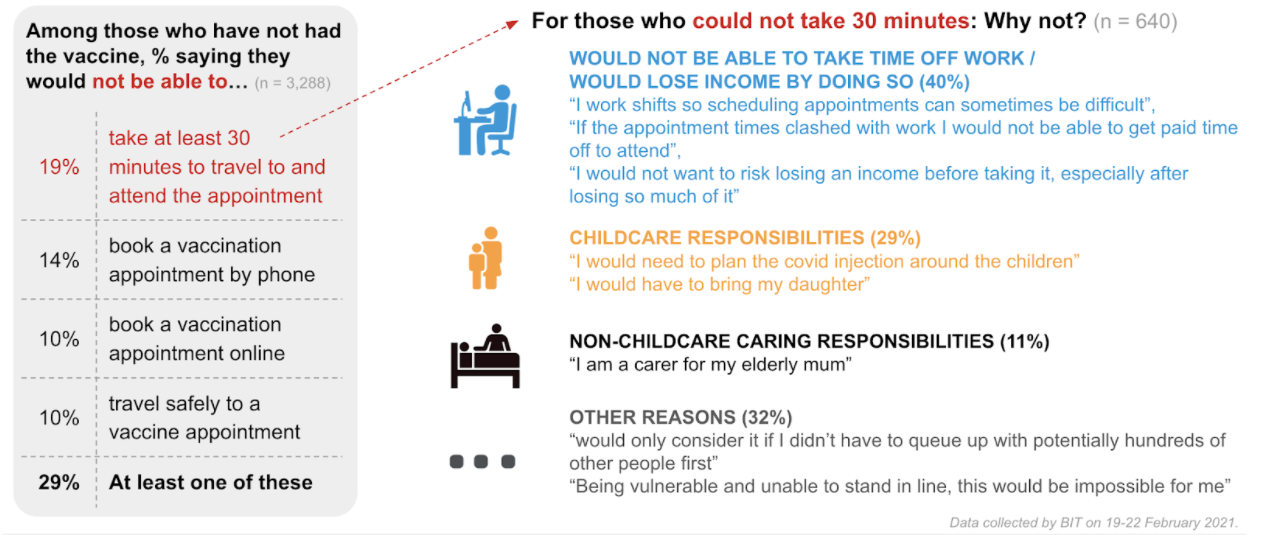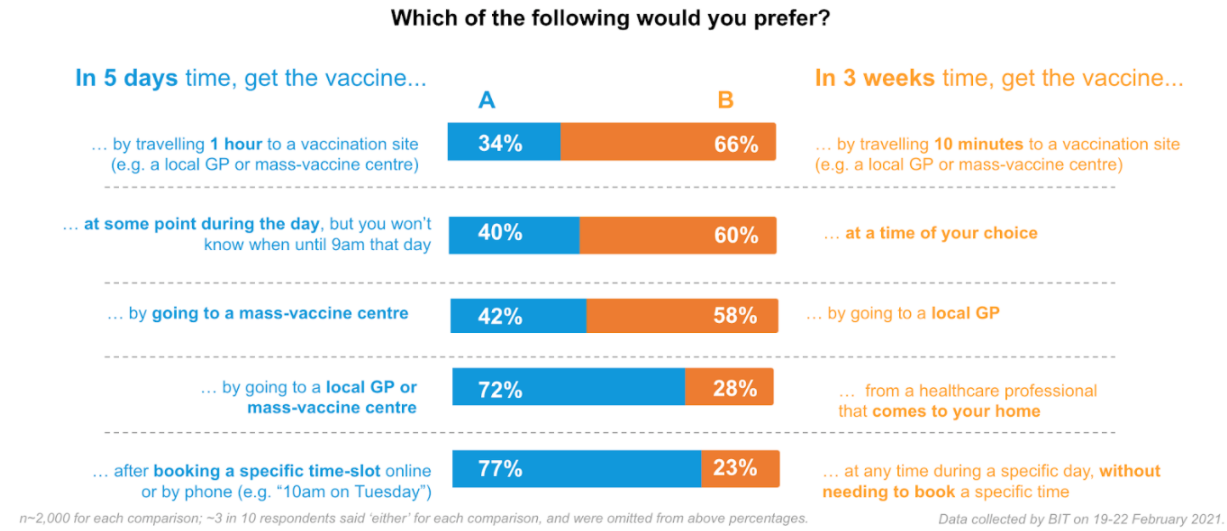As of April 7th, 47.3% of the UK population (or 59.8% of UK adults) have received at least one dose of coronavirus vaccine. Although many regions of the country are still experiencing vaccine shortages, an increase in supply seems to be on the horizon, due to the arrival of additional stocks of the Moderna vaccine. As the UK is approaching the stage where every adult could get a free NHS coronavirus vaccine, we were keen to understand if everyone might actually get their vaccine.
People’s willingness to receive the coronavirus vaccine in the UK is the highest it has been to date — 9 in 10 of Britons currently say they would take it when the NHS notifies them it is their turn, vs 7 in 10 in December.
However, people’s willingness to receive the coronavirus vaccine may not be enough to actually get it. Large intention-action gaps have long been observed in many health behaviours, and it’s likely that some practical barriers will get in the way for many groups. To pre-empt this intention-action gap, we ran an online experiment with a representative sample of 4,085 UK adults to find out what key barriers might make Britons less likely to get vaccinated or put off vaccination and how to address them ahead of time.
Eliciting potential barriers for getting a coronavirus vaccine
Guided by Susan Michie and her colleagues’ COM-B model of behavioural change, we first probed people’s motivational barriers. For people that didn’t intend to get a vaccine (said “no” or “not sure”), we asked them to choose from seven potential reasons or enter other reasons.
We then examined people’s practical (capabilities and opportunities) barriers. We asked those that intended to get a vaccine (but hadn’t yet) whether they would be able to do the following (top four most common barriers according to focus group studies commissioned by the DHSC):
- Having more than 30 minutes to travel to and attend the appointment
- Means to travel safely to a vaccine appointment (by car/motorbikes, public transport, bike, or walking)
- Booking a vaccination appointment by phone
- Booking a vaccination appointment online
As BIT’s EAST framework points out, even if people are able to do a task, they might put it off (sometimes indefinitely) when the task becomes effortful, i.e. when these ‘friction costs’ are too high. To gauge the extent to which people would put off vaccination due to practical inconveniences, we designed 5 trade-off scenarios (as shown in the table below) where people were asked to choose between option A – getting a vaccine earlier with more hassle and option B – getting a vaccine later with less hassle.

What we found
Vaccine hesitancy was much lower compared to last December, with only 8% of those that hadn’t already been offered a vaccine saying they wouldn’t want it, along with a further 10% that felt unsure. The most cited reason for the hesitant people was concerns about side-effects. Though they felt hesitant now, 28% of them were open to taking a ‘wait and see’ approach, and might be reassured about the vaccine’s safety as more people get vaccinated.
When looking at all participants who were yet to receive the vaccine, the capabilities and opportunities barriers offer a more substantial concern. We found that 29% of people said they could not overcome at least one of the four above-mentioned barriers: 19% couldn’t spare more than 30 minutes to travel to and attend their appointment, 14% couldn’t book an appointment online, 10% couldn’t book via phone and 10% couldn’t travel safely to a vaccination site.

When this group were then presented with the 5 trade-off scenarios, about 2 in 3 people would put off vaccination (chose option B instead of option A) when they:
- Had to travel for a long time (1 hour vs. 10 min) to a vaccination site
- Couldn’t choose when to visit a vaccination site (being told when to come vs. coming at a time of choice)
- Had to make more logistical arrangement (travelling to a vaccination site vs. going to their GP)

Notably, these practical barriers were even more impactful among those that were less determined to get vaccinated. When excluding those that said they would definitely be willing to receive the vaccine, 4 in 5 people would put off vaccination when faced with the top three barriers.
Conclusion
Our findings suggest that Britons are overall keen to get a vaccine, but their intention to do so might be impeded by some practical barriers, particularly among the more hesitant group. Most notably, they faced potential barriers such as making time for a vaccination trip, booking an appointment at a time slot of their choice, and travelling easily to the vaccination site.
We believe those seemingly trivial inconveniences would have a material impact on the vaccination rate — the Liverpool mass testing pilot found that testing uptake fell by 27% for every 1km further from a site, illustrating the importance of convenience. Recently, New York State has enacted a law that grants employees up to 4 hours paid leave to get a vaccine. Some employers with large workforce have also set up on-site vaccine clinics to make vaccination more accessible to employees.
Through policies such as these, we can take full advantage of the high vaccine acceptance rate we are seeing across the UK, and stop practical barriers from interrupting the key steps towards increasing immunity in the population.








